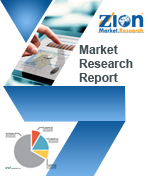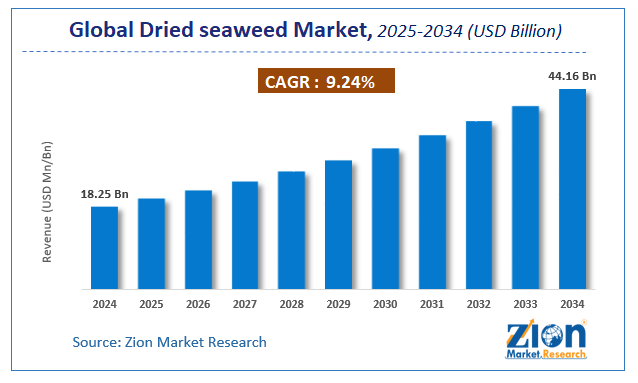Global Dried seaweed Market Size, Share, Growth Analysis Report - Forecast 2034

Dried seaweed Market By Type (Kombu, Wakame, Dulse, Nori, Kelp, Others), By Application (Food, Medicine, Skincare, Anti-Pollutants, Others), and By Region: Global and Regional Industry Overview, Market Intelligence, Comprehensive Analysis, Historical Data, and Forecasts 2025 - 2034
| Market Size in 2024 | Market Forecast in 2034 | CAGR (in %) | Base Year |
|---|---|---|---|
| USD 18.25 Billion | USD 44.16 Billion | 9.24% | 2024 |
Dried seaweed Market: Industry Perspective
The global dried seaweed market size was worth around USD 18.25 Billion in 2024 and is predicted to grow to around USD 44.16 Billion by 2034 with a compound annual growth rate (CAGR) of roughly 9.24% between 2025 and 2034. The report analyzes the global dried seaweed market's drivers, restraints/challenges, and the effect they have on the demands during the projection period. In addition, the report explores emerging opportunities in the dried seaweed industry.
Dried Seaweed Market: Overview
Seaweed is an extremely common marine algae and plant that can be found in all water bodies like the ocean, lakes, rivers, and others. Some species of seaweeds are microscopic and remain suspended in water columns and act as food-providing agents for marine food systems. While others are giants, easily visible to the human eye.
The water algae are full of vitamins, fiber, and minerals, and are edible. For more than 15 centuries, Japanese culture has adopted seaweeds for multiple applications ranging from using them as healing agents to food items. Some forms of seaweed contain antimicrobial and anti-inflammatory properties, hence were popularly used in ancient times. Dried seaweed is known for its numerous health benefits and is consumed in many diet cultures. However, it is important to thoroughly clean and dry the seaweed before it is consumed for appropriate results.
Key Insights
- As per the analysis shared by our research analyst, the global dried seaweed market is estimated to grow annually at a CAGR of around 9.24% over the forecast period (2025-2034).
- Regarding revenue, the global dried seaweed market size was valued at around USD 18.25 Billion in 2024 and is projected to reach USD 44.16 Billion by 2034.
- The dried seaweed market is projected to grow at a significant rate due to increasing health consciousness, demand for plant-based nutrition, rising popularity of Asian cuisines, and expanding use in food, cosmetics, and agriculture.
- Based on Type, the Kombu segment is expected to lead the global market.
- On the basis of Application, the Food segment is growing at a high rate and will continue to dominate the global market.
- Based on region, Asia-Pacific is predicted to dominate the global market during the forecast period.
Dried Seaweed Market: Growth Drivers
Rising awareness about the benefits of dried seaweed to propel market growth
The global dried seaweed market is projected to benefit from the rising awareness about the benefits imparted by dried seaweed consumption. Post the impact of Covid-19, more people are now looking for options to help them improve their immunity and eating habits by involving a mixture of vitamins, minerals, fiber, etc. in their daily diet. Moreso, there is a rising trend of incorporating plant-based diets instead of animal meat.
These factors have resulted in exploration toward understanding the exact health benefits that dried seaweed along with other non-animal plants have to offer. Since seaweed is known to be an excellent source of protein, carbohydrates, and minerals, which is a rare combination to find in single animal meat, it is gaining more popularity among consumers. Fiber-rich food items are recommended for diabetic patients, and seaweed consumption may help with the disease. A 2018 study using rats as subjects concluded that a certain type of seaweed can help control type 2 diabetes. However, more research is needed on the subject.
Dried Seaweed Market: Restraints
Concerns over the presence of heavy metals in seaweed to restrict the market growth
Excessive consumption of dried seaweeds is not recommended as it may have unwanted implications on human health. There are growing concerns about the presence of heavy metals in seaweeds since the source of absorption in seaweeds is the water body itself. Even though the level of heavy metals may be low but regular consumption may build up in the body turning it toxic.
Dried Seaweed Market: Opportunities
Assistance in maintaining heart condition to provide growth opportunities
The global dried seaweed market size may benefit from the properties of dried seaweed in helping maintain the heart’s condition owing to its fibrous-rich content along with the presence of high levels of antioxidants. As per the Centers for Disease Control & Prevention, the United States witnesses 1 death in every 34 seconds from cardiovascular diseases (CVDs). The growing concern and efforts on a personal level by the general population to curb these conditions are projected to provide growth opportunities as the demand for the product grows.
Dried Seaweed Market: Challenges
Rising water pollution to challenge market growth
The overall aquaculture industry is anticipated to suffer declining growth because of increasing water pollution which has impacted the marine culture to extreme limits. The quality of aqua products has reduced drastically and more people are refraining from consuming these items owing to the presence of high numbers and potentially dangerous water pollutants that come back into the human food cycle when water-borne items are consumed. As per the National Research Development Corporation, around 80% of wastewater returns to the environment.
Dried seaweed Market: Segmentation Analysis
The global dried seaweed market is segmented based on Type, Application, and region.
Based on Type, the global dried seaweed market is divided into Kombu, Wakame, Dulse, Nori, Kelp, Others.
On the basis of Application, the global dried seaweed market is bifurcated into Food, Medicine, Skincare, Anti-Pollutants, Others.
Dried seaweed Market: Report Scope
| Report Attributes | Report Details |
|---|---|
| Report Name | Dried seaweed Market |
| Market Size in 2024 | USD 18.25 Billion |
| Market Forecast in 2034 | USD 44.16 Billion |
| Growth Rate | CAGR of 9.24% |
| Number of Pages | 186 |
| Key Companies Covered | Marcel Carrageenan, Seaweed Solutions AS, Green Ocean Farming, AtSeNova, Nantong Xinlang Seaweed & Foods Co., Ltd., Beijing Leili Agricultural Co., Organic Irish Seaweed-Emerald Isle, and others. |
| Segments Covered | By Type, By Application, and By Region |
| Regions Covered | North America, Europe, Asia Pacific (APAC), Latin America, The Middle East and Africa (MEA) |
| Base Year | 2024 |
| Historical Year | 2020 to 2023 |
| Forecast Year | 2025 - 2034 |
| Customization Scope | Avail customized purchase options to meet your exact research needs. Request For Customization |
Dried Seaweed Market: Regional Analysis
Asia-Pacific to lead the market cap during the projection period
The global dried seaweed market is projected to be dominated by Asia-Pacific since it already has an immense hold on densely populated countries like Japan, India, and China. Marine algae is a constant in various diet cultures in the region especially in Japan, the Republic of Korea, and China. These three territories are regarded as the largest consumers of seaweed in the entire world, especially in the food segment.
The Republic of Korea is reported to produce over 60,000,00 tonnes of wet seaweed annually with a market value of USD 5 billion. China is termed the largest producer of edible seaweed with over 5 million tonnes of seaweed dominated by kombu produced every year. The growing seaweed industry in India is projected to help regional growth in the coming years. This is expected to be driven by the presence of vast coastal lines across the country's border making it a potential HubSpot for seaweed farming.
Recent Developments:
- In April 2022, research scholars at King Faisal University in Saudi Arabia published a report concluding that dried seaweed can be used to separate and remove extremely toxic textile dye found in industrial wastewater. The study was conducted on methylene blue dye. Textile effluents are termed as the most harmful environmental pollutants owing to the presence of toxic dyes.
- In September 2021, Lakshadweep, an Indian island, initiated seaweed farming in nine of its inhabited islands. The step is following a study led by the Central Marine Fisheries Research Institute claiming that there is high potential to find high-quality seaweeds in non-polluted lagoons. These seaweeds can be used in the food, pharmaceutical, and nutraceutical industries.
Dried seaweed Market: Competitive Analysis
The report provides a company market share analysis to give a broader overview of the key market players. In addition, the report also covers key strategic developments of the market, including acquisitions & mergers, new product launches, agreements, partnerships, collaborations & joint ventures, research & development, and regional expansion of major participants involved in the dried seaweed market on a global and regional basis.
The global dried seaweed market is dominated by players like:
- Marcel Carrageenan
- Seaweed Solutions AS
- Green Ocean Farming
- AtSeNova
- Nantong Xinlang Seaweed & Foods Co. LTD.
- Beijing Leili Agricultural Co.
- Organic Irish Seaweed-Emerald Isle
The global dried seaweed market is segmented as follows;
By Type
- Kombu
- Wakame
- Dulse
- Nori
- Kelp
- Others
By Application
- Food
- Medicine
- Skincare
- Anti-Pollutants
- Others
By Type
- Kombu
- Wakame
- Dulse
- Nori
- Kelp
- Others
By Region
- North America
- The U.S.
- Canada
- Europe
- France
- The UK
- Spain
- Germany
- Italy
- Rest of Europe
- Asia Pacific
- China
- Japan
- India
- South Korea
- Southeast Asia
- Rest of Asia Pacific
- Latin America
- Brazil
- Mexico
- Rest of Latin America
- Middle East & Africa
- GCC
- South Africa
- Rest of Middle East & Africa
Table Of Content
Methodology
FrequentlyAsked Questions
Seaweed is an extremely common marine algae and plant that can be found in all water bodies like the ocean, lakes, rivers, and others.
The global dried seaweed market is expected to grow due to health-conscious diets, demand for plant-based nutrition, and the popularity of Asian cuisine globally.
According to a study, the global dried seaweed market size was worth around USD 18.25 Billion in 2024 and is expected to reach USD 44.16 Billion by 2034.
The global dried seaweed market is expected to grow at a CAGR of 9.24% during the forecast period.
Asia-Pacific is expected to dominate the dried seaweed market over the forecast period.
Leading players in the global dried seaweed market include Marcel Carrageenan, Seaweed Solutions AS, Green Ocean Farming, AtSeNova, Nantong Xinlang Seaweed & Foods Co., Ltd., Beijing Leili Agricultural Co., Organic Irish Seaweed-Emerald Isle, among others.
The report explores crucial aspects of the dried seaweed market, including a detailed discussion of existing growth factors and restraints, while also examining future growth opportunities and challenges that impact the market.
RelatedNews
HappyClients
Zion Market Research
Tel: +1 (302) 444-0166
USA/Canada Toll Free No.+1 (855) 465-4651
3rd Floor,
Mrunal Paradise, Opp Maharaja Hotel,
Pimple Gurav, Pune 411061,
Maharashtra, India
Phone No +91 7768 006 007, +91 7768 006 008
US OFFICE NO +1 (302) 444-0166
US/CAN TOLL FREE +1 (855) 465-4651
Email: sales@zionmarketresearch.com
We have secured system to process your transaction.
Our support available to help you 24 hours a day, five days a week.
Monday - Friday: 9AM - 6PM
Saturday - Sunday: Closed





